(Editor's Note: For reasons of which we are all aware, traveling today in Jordan
can be a dangerous proposition. Misti traveled through Jordan somewhat before
we invaded and occupied Iraq).
There is something magical about immersing yourself into a completely new culture
- where the language is unfamiliar, the beat of the music sounds almost anomalous,
the tastes and smells are an adventure of their own, and the religion an entirely
new way of life to explore. Traveling to Jordan during the Islamic holiday of
Ramadan was an eye-opening experience.
It was late in the evening in early December when my friend and I flew into the capital city of Amman. We were greeted by Arabic speaking guards holding machine guns and ushered through customs where we met our private tour guide, Fathi. He would be our fearless leader throughout this four-day adventure, navigating the country and teaching us about life in Jordan. I had three major goals for our trip: to float in the Dead Sea, to visit the ancient city of Petra, and to observe and experience Ramadan.
Ramadan is the Islamic Holiday that is celebrated annually during the ninth
month of the Muslim calendar. Throughout the month the faithful fast from food,
drink, smoking, and sexual intercourse every day during daylight. This month
represents a time for contemplation and worship as well as an opportunity to
cleanse the body and strengthen family and community ties. Fathi described this
as an opportunity to get healthy and appreciated the resulting health and spiritual
benefits.
We spent our first night at the Movenpick Dead Sea Resort. We awoke to a warm,
sunlit morning overlooking a gorgeous resort perched on the edge of the Dead
Sea. We walked to the shore, looked across the sea to Israel, floated on top
of the water, and examined the salt encrusted rocks scattered about. The Dead
Sea is truly fascinating. Beginning at 1300 feet below sea level at the surface,
it is the lowest elevation in the world and it gets lower every year due to
its location in the East Rift Valley. Water flows into the Sea through rivers
and streams, but the only way it escapes is through evaporation leaving behind
a high concentration of salt and minerals. This concentration creates high-density
water resulting in buoyancy. I was literally sitting on top of the water with
no need to paddle or kick to stay afloat. The water feels cool and very similar
to the ocean at first touch, but as you paddle and float you come to realize
the density.
Fathi returned to our hotel in the afternoon for our departure to Wadi Musa, the gateway to Petra. We headed south on the Kings Highway and stopped at Mt. Nebo for vistas of Jerusalem across the Dead Sea and to walk the hills where Moses is fabled to have ascended into heaven. We continued on to the village of Madaba to stretch our legs and view the centuries old mosaics, including a Byzantine era map of Palestine dating back to 560 CE, estimated to be comprised of a staggering two million pieces. We grabbed a snack at a café, but were very careful about eating in public out of respect for the Ramadan fast. We learned quite a bit about the holiday and the faithful followers who fasted every day for nearly a month. As the sun set Islamic prayers were chanted from the peaks of the mosques ending the daily fast. These echoing chants went on for a few moments with an enchanting rhythm resonating peace and tranquility. We sat with Fathi as he ended his fast and satisfied his hunger with a simple meal of dates and nuts and quenched his thirst with water.
As we drove south to Petra, Fathi told us of his family, life experience and his different way of life in Jordan. His grandfather was exiled from Israel and relocated to Amman. Fathi carried the anger of his forefathers for being taken from his homeland and having lost so much. As he described the work his family had done to rebuild everything they had in Israel, the bitterness and jealousy he felt was evident.
Fathi is married with four children and when asked how he had met his wife he told us that their marriage had not been arranged, but that he had known her all of his life. With much effort in translation he was finally able to communicate that he had married his cousin... He went on to say that he had heard we discourage this in the United States.
We arrived in the small town of Wadi Musa in the evening. After dinner at our hotel we set out on foot to explore this village that seemed to trickle down the barren hills of southern Jordan. We knew we were steps away from the mystifying Petra, but would have to wait until morning for the sunlight to reveal it to us. The youth of Wadi Musa were gathered in a few small convenient stores and cafes, listening to music on portable radios and conversing back and forth.
The following morning our trip to Petra had finally arrived. Petra, whose name means, "rock" in Arabic, has always fascinated me with its ancient history and intricately carved structures. Petra flourished for hundreds of years as a commercial center and fortress protected by rock walls. It had the geographic advantage of falling along a main trade route through the Middle East and served as a primary stop for caravans carrying goods for trade. Petra was first inhabited by the Edomites around 1200 BCE, then the Naabataeans in the year 312 BCE, and finally the Romans in 63 BCE. After 550 CE little was known of Petra and it was not revealed to the Western world until 1812 when Johann Ludwig Burckhardt, the Swiss explorer, uncovered it.
We met our private Petra guide at the entrance to the historic monument and headed into the initial canyons that would open up to the Ancient City of Petra. We soon found ourselves walking in a narrow cleft, or Siq in Arabic, between towering walls of red rock. As we walked through the passage our guide told us of the many civilizations that occupied this space and traveled these same steps, the battles that had taken place between the different inhabitants, and the natural forces that had changed the shape of the rock. The anticipation of reaching the end of the passage and revealing the intricate buildings carved from stone was intensifying.
 |
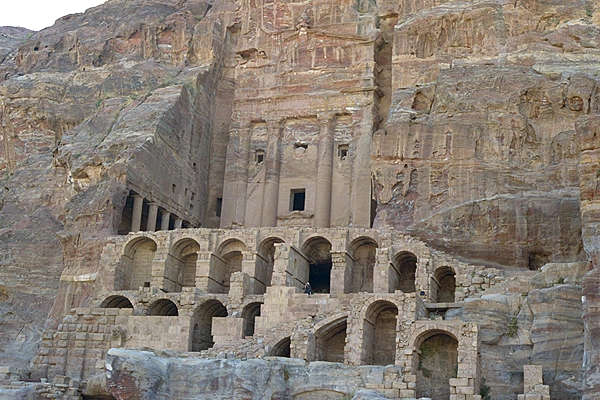 |
|
Shops and dwellings in the rock
|
Expansive tomb
|
As we saw the open and light space coming ahead of us we knew we were near the city. We walked out of the cleft and stood before the Treasury with its impressive columns reaching over 100 feet up the cliff to meet the pitch of the roofline. This beautiful building, made famous by scenes from Indiana Jones: The Last Crusade, was magnificently carved from the cliffs of the Petra Valley. We peered inside to what was actually a royal tomb at one time.
We walked beyond the Treasury and saw what was at one time a main thoroughfare through town, with many facades worn down through the centuries. We marveled at the swirls of reds, purples, blues and greens throughout the carved stone as we explored many of the buildings. We hiked to the coliseum that served as the gathering place for generations of inhabitants and imagined the performances and entertainment that took place.
At the time of our visit, Brown University had just begun the excavation of an ancient church and Christian mosaics were being revealed. We bought art made from the sand left behind and talked with the local artisans watching over the excavation project. They took a damp sponge and wiped the dust from the mosaic to reveal the true, vibrant colors.
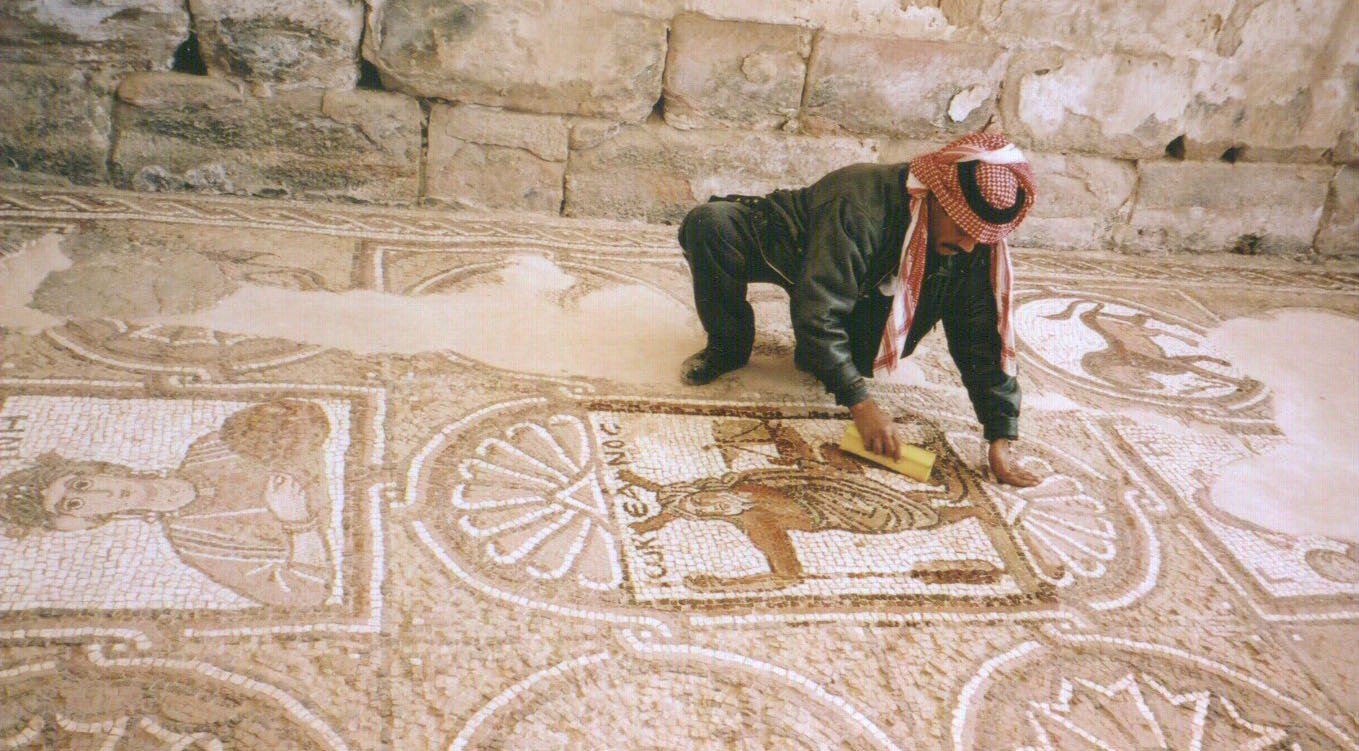 |
|
|
Washing the tiles of time
|
At this point we were ready for lunch and enjoyed a variety of traditional Middle Eastern food at a small restaurant within Petra. The lunch included fresh hummus with tahini, tabhouli, eggplant, cucumber salad, and some lentil puree all served with mint tea and pita bread. After lunch we decided to take camels back to the entrance and enjoyed their awkward grace as they made their way to the entrance.
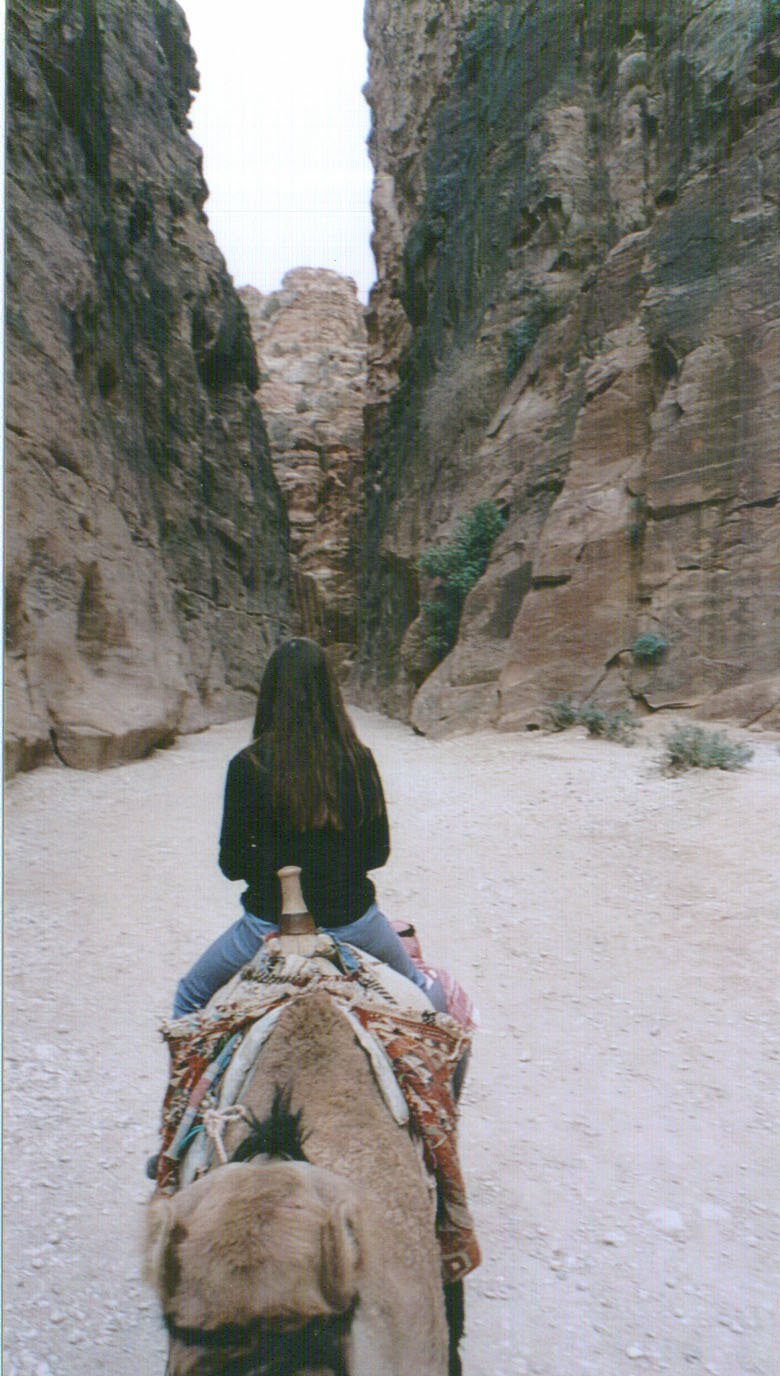 |
|
|
The narrow entrance to Petra
|
It was mid-afternoon when we arrived back at the entrance and Fathi was waiting.
We loaded our things and headed north to the capital of Amman for our final
night in Jordan. As we left we felt like most of the excitement of our trip
was over; little did we know we were about to experience something utterly amazing.
With little commercial development between Wadi Musa and Amman, our options
for a stopping point were limited. Fathi had been fasting all day and it was
important for him to end the fast by listening to the prayer and eating with
friends. Fathi asked us if we would mind stopping at an old Crusader Castle
on top of a barren hill in Southern Jordan. At this point we understood the
importance of this daily event and agreed to his request. He described the crusades
that took place about 1000 years ago as an effort to convert the area to Christianity
resulting in bloody battles and leaving behind these Crusader Castles built
as military fortresses.
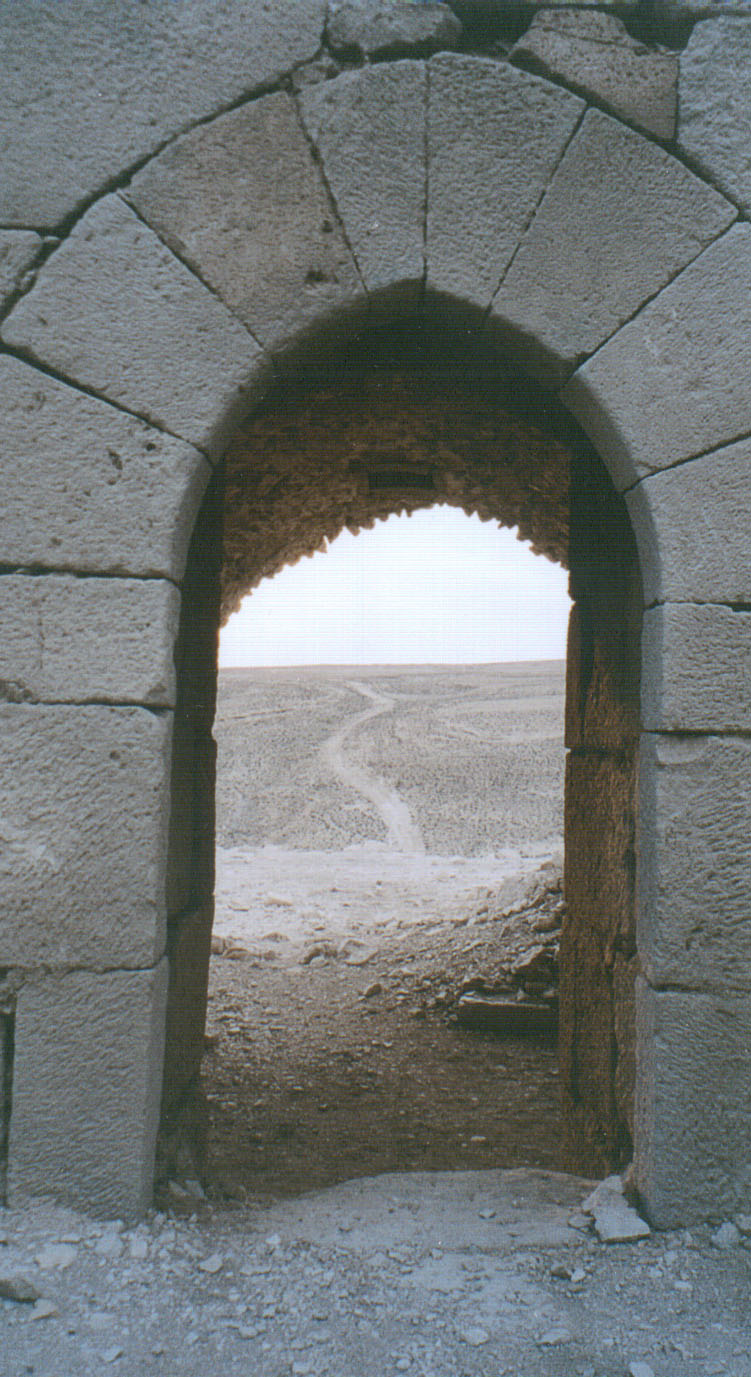 |
|
|
Crusaders entered the Castle through this arch
|
The outline of the castle began to appear on top of a hill in the distance
as we wound our way through the hills toward the castle. As we arrived the sun
was beginning to set. Fathi entered a tent just outside the walls of the castle
and invited us in. We met his friends as they were preparing a simple meal over
a propane stove. I walked out of the tent and explored the ruins of the castle
taking in the endless vistas of desolate land, which seemed to turn shades of
purple as the sun sunk closer to the horizon. There was one man who actually
lived in the castle who took a liking to me and gave me the gift of a handmade
necklace for visiting his home. Fathi explained that he was actually a government
employee living at the castle as a caretaker.
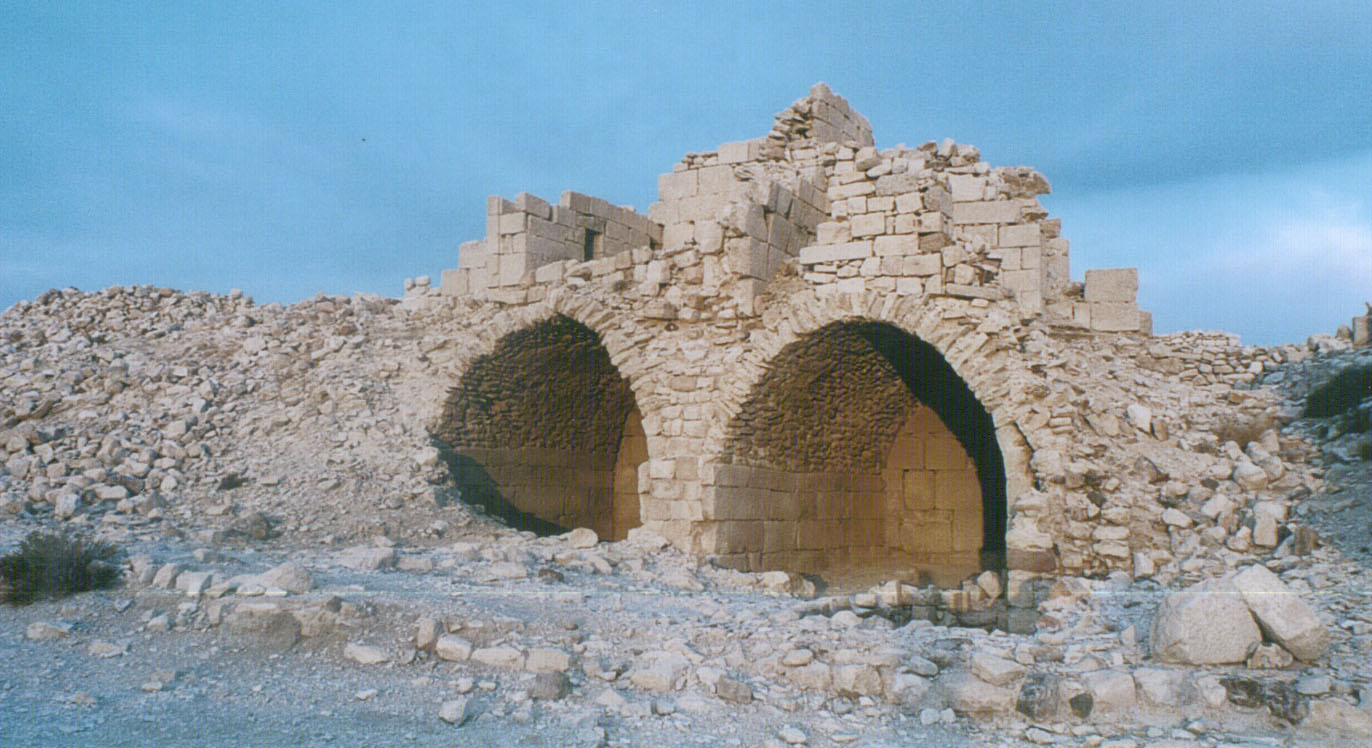 |
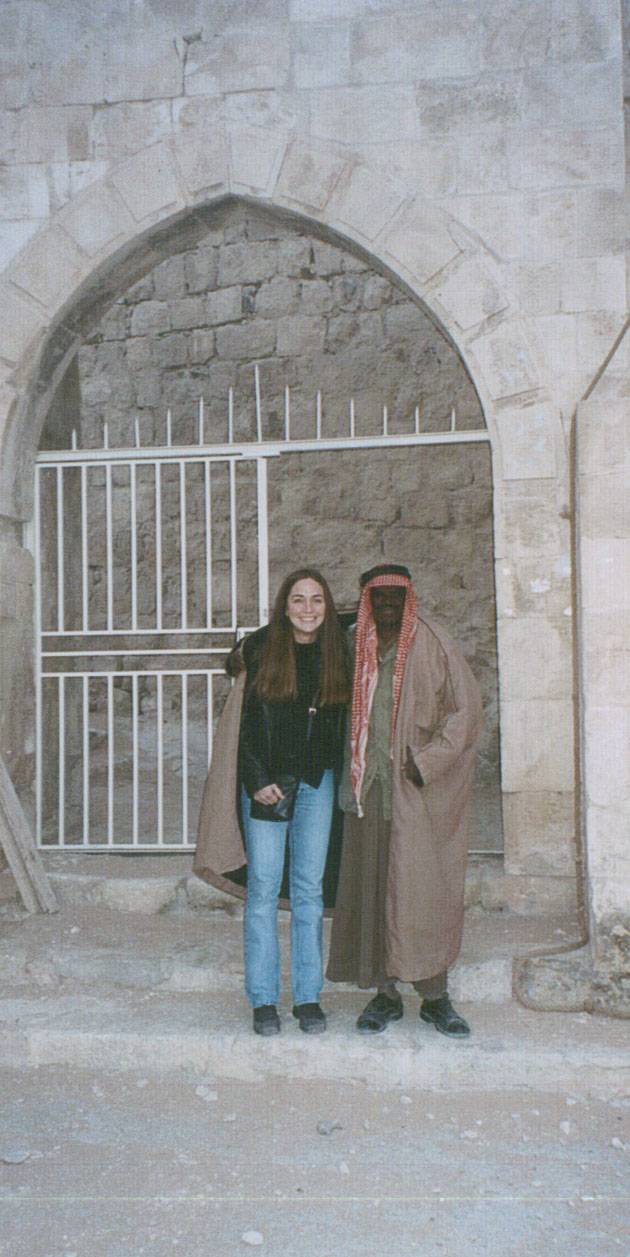 |
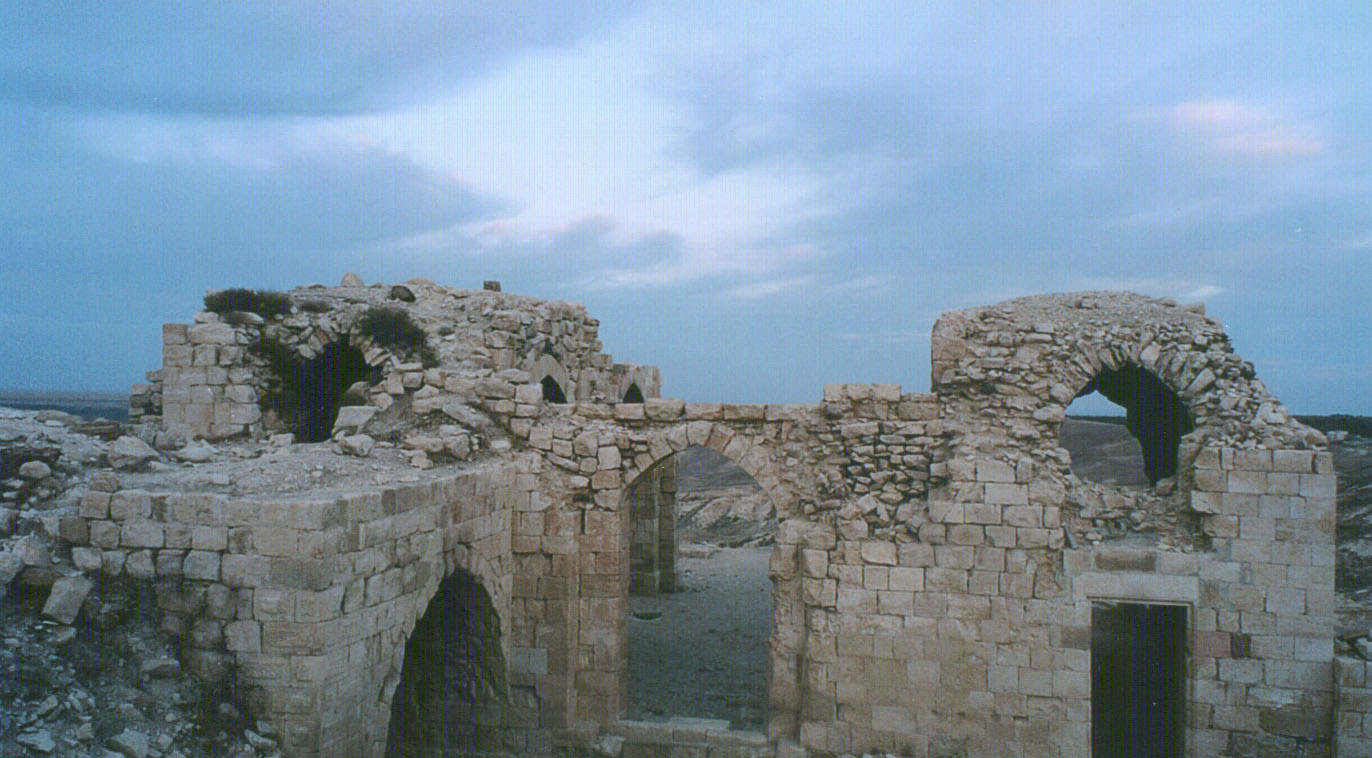 |
|
Crusader's castle
|
Misti gets a warm-up
|
Castle arches remain through time
|
As I walked back toward the tent I heard the prayers that were being chanted
over the radio and saw Fathi praying outside the tent and bowing in a series
of motions toward the hills beyond the castle. Observing this act of faith he
made the effort to accommodate at the end of a long day of work was very moving.
He stood and I joined him to walk back into the tent. He shared a quick meal
with his friends and we gathered our things and left.
 |
|
|
Dinner in the tent
|
Fathi drove us back to Amman, checked us into our hotel, and dropped us off in the center of town. As we left Fathi we thanked him for the generosity of his time and knowledge. We were standing at the heart of Amman is a Roman theatre that seats 6000 people, a forum, and a street of columns from what once was the center of the Roman city of Philadelphia. We walked through the ruins, which were beautifully lit against the night sky, and crossed the street to join the crowds of people shopping an eating. We walked down the street and noticed families walking together and enjoying the pleasant evening in celebration of Ramadan. A bakery with baklava stacked from floor to ceiling caught our eye and we ventured in to sample a small assortment. We tried the sweet, paper-like pastry and purchased tins to bring back to friends and family.
After a long day we were ready to return to the hotel and prepare for our early morning flight home. We reflected on the time we had spent in Jordan and the cultural experience that had proven to be more rewarding than we had imagined. The Jordanians were a welcoming, faithful and proud people in spite of the hardships they had endured through the wars. Their faith, illustrated so eloquently through the Ramadan holiday, was humbling and we were reminded of the focus we so often misplace on material things.
* CE stands for "Common Era." It is a relatively new term that is
experiencing increased usage and is eventually expected to replace AD. The latter
is an abbreviation for "Anno Domini" in Latin or "the year of
the Lord" in English. The latter refers to the approximate birth year of
Yeshua of Nazareth (a.k.a. Jesus Christ). CE and AD have the same and value.
2004 CE = 2004 AD.
BCE stands for "Before the common era." It is eventually expected
to replace BC, which means "Before Christ." BC and BCE are also identical
in value. Most theologians and religious historians believe that the approximate
birth date of Yeshua of Nazareth (Jesus) was in the fall, sometime between 7
and 4 BCE, although we have seen estimates as late as 4 CE and as early as the
second century BCE. http://www.religioustolerance.org/ce.htm